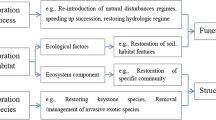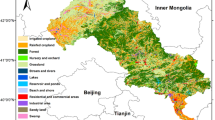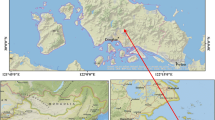Abstract
The nexus exploration among land use/land cover change, ecosystem services and human well-being has been increasingly crucial in the context of Future Earth. However, the spatial heterogeneity and the entwining process among these three aspects have not yet been in-depth and systematically explored. Here we identified the spatiotemporal pattern of ecosystem services during the past 20 years in Yushu, the eco-fragile region and the centre of Qinghai-Tibet Plateau, as well as clarified its relationships with land use change and human well-being. We revealed that: (1) The structure of the ecosystem and land use in this area have been increasingly stable, and the ecological projects have exerted a positive impact. (2) Although the ecological environmental issues still need more attention, the ecosystem services of the area have been positively developing. (3) Derived by the ecosystem services increase, environmental projects and policies, the human well-beings of culture and education performed much better than other aspects. (4) It is crucial to carry out long-term ecological projects and increase educational investment for maintaining the stability of this ecologically fragile area. This study provides significant support for the regional ecological sustainability decision making, especially for the Qinghai-Tibet Plateau, the roof of the world.
Similar content being viewed by others
References
Bai Y, Ochuodho T O, Yang J, 2019. Impact of land use and climate change on water-related ecosystem services in Kentucky, USA. Ecological Indicators, 102: 51–64.
Bohensky E L, Reyers B, Van Jaarsveld A S, 2010. Future ecosystem services in a Southern African river basin: A scenario planning approach to uncertainty. Conservation Biology, 20(4): 1051–1061.
Bongaarts J, 2019. Summary for policymakers of the global assessment report on biodiversity and ecosystem services of the Intergovernmental Science-Policy Platform on Biodiversity and Ecosystem Services. Population and Development Review, 45(3): 680–681.
Brown M T, Vivas M B, 2005. Landscape development intensity index. Environmental Monitoring & Assessment, 101(1–3): 289–309.
Bunsen J, Berger M, Finkbeiner M, 2021. Planetary boundaries for water: A review. Ecological Indicators, 121: 107022.
Cabral P, Feger C, Levrel H et al., 2016. Assessing the impact of land-cover changes on ecosystem services: A first step toward integrative planning in Bordeaux, France. Ecosystem Services, 22: 318–327.
Che L, Zhou L, Xu J, 2021. Integrating the ecosystem service in sustainable plateau spatial planning: A case study of the Yarlung Zangbo River Basin. Journal of Geographical Sciences, 31(2): 281–297.
Chen C, Park T, Wang X et al., 2019. China and India lead in greening of the world through land-use management. Nature Sustainability, 2(2): 122–129.
Chen W, Zhao H, Li J et al., 2020. Land use transitions and the associated impacts on ecosystem services in the middle reaches of the Yangtze River Economic Belt in China based on the geo-informatic Tupu method. The Science of the Total Environment, 701: 134690.
Chillo V, Vázquez D P, Amoroso M M et al., 2018. Land use intensity indirectly affects ecosystem services mainly through plant functional identity in a temperate forest. Functional Ecology, 32(5): 1390–1399.
Chu H, Wei J, Qiu J et al., 2019. Identification of the impact of climate change and human activities on rainfall-runoff relationship variation in the Three-River Headwaters region. Ecological Indicators, 106: 105516.
Crabtree R, Potter C, Mullen R et al., 2009. A modeling and spatio-temporal analysis framework for monitoring environmental change using NPP as an ecosystem indicator. Remote Sensing of Environment, 113(7): 1486–1496.
Cui F, Wang B, Zhang Q et al., 2020. Climate change versus land-use change: What affects the ecosystem services more in the forest-steppe ecotone? Science of the Total Environment, 759: 143525.
Du Q, Zhang M, Wang S et al., 2019. Changes in air temperature over China in response to the recent global warming hiatus. Journal of Geographical Sciences, 29(4): 496–516.
Farella G, Menegon S, Fadini A et al., 2020. Incorporating ecosystem services conservation into a scenario-based MSP framework: An Adriatic case study. Ocean & Coastal Management, 193: 105230.
Fedele G, Locatelli B, Djoudi H, 2017. Mechanisms mediating the contribution of ecosystem services to human well-being and resilience. Ecosystem Services, 28: 43–54.
Gao H, Li Z, Peng Li et al., 2016. The capacity of soil loss control in the Loess Plateau based on soil erosion control degree. Journal of Geographical Sciences, 26(4): 457–472.
Gomes L C, Bianchi F J J A, Cardoso I M et al., 2020. Land use change drives the spatio-temporal variation of ecosystem services and their interactions along an altitudinal gradient in Brazil. Landscape Ecology, 35(7): 1571–1586.
Guo B, Han B, Yang F et al., 2020. Determining the contributions of climate change and human activities to the vegetation NPP dynamics in the Qinghai-Tibet Plateau, China, from 2000 to 2015. Environmental Monitoring and Assessment, 192(10): 663.
Han Z, Long D, Fang Y et al., 2019. Impacts of climate change and human activities on the flow regime of the dammed Lancang River in Southwest China. Journal of Hydrology, 570: 96–105.
Jiang C, Zhang L, 2015. Climate change and its impact on the eco-environment of the Three-Rivers Headwater Region on the Tibetan Plateau, China. International Journal of Environmental Research and Public Health, 12(10): 12057–12081.
Lavorel S, Grigulis K, Leitinger G et al., 2017. Historical trajectories in land use pattern and grassland ecosystem services in two European alpine landscapes. Regional Environmental Change, 17(8): 2251–2264.
Lester D, 2013. Measuring Maslow’s hierarchy of needs. Psychological Reports, 113(1): 15–17.
Lin T, Xue X, Shi L et al., 2013. Urban spatial expansion and its impacts on island ecosystem services and landscape pattern: A case study of the island city of Xiamen, Southeast China. Ocean & Coastal Management, 81: 90–96.
Liu F, Zeng Y, 2019. Spatial-temporal change in vegetation net primary productivity and its response to climate and human activities in Qinghai Plateau in the past 16 years. Acta Ecologica Sinica, 39(5): 1528–1540. (in Chinese)
Lufafa A, Tenywa M M, Isabirye M et al., 2003. Prediction of soil erosion in a Lake Victoria basin catchment using a GIS-based Universal Soil Loss model. Agricultural Systems, 76(3): 883–894.
Mack J J, 2006. Landscape as a predictor of wetland condition: An evaluation of the landscape development index (LDI) with a large reference wetland dataset from Ohio. Environmental Monitoring & Assessment, 120(1–3): 221–241.
Margriter S C, Bruland G L, Kudray G M et al., 2014. Using indicators of land-use development intensity to assess the condition of coastal wetlands in Hawaii. Landscape Ecology, 29(3): 517–528.
Matamala R, Gonzàlez-Meler M A, Jastrow J D et al., 2003. Impacts of fine root turnover on forest NPP and soil sequestration potential. Science, 302(5649): 1385–1387.
Millennium Ecosystem Assessment (MEA), 2005. Ecosystems and human well-being: Synthesis. World Health, 1134: 25–60.
Ouyang Z, Zheng H, Xiao Y et al., 2016. Improvements in ecosystem services from investments in natural capital. Science, 352(6292): 1455–1459.
Qi S, Jiang M, Yu X, 2011. Evaluating soil erosion in Jiangxi Province with USLE model and remote sensing technology during 1995–2005. China Environmental Science, 31(7): 1197–1203. (in Chinese)
Quintas-Soriano C, Castro A J, Castro H et al., 2016. Impacts of land use change on ecosystem services and implications for human well-being in Spanish drylands. Land Use Policy, 54: 534–548.
Reiss K C, Hernandez E, Brown M T, 2014. Application of the landscape development intensity (LDI) index in wetland mitigation banking. Ecological Modelling, 271: 83–89.
Riao D, Zhu X, Tong Z et al., 2020. Study on land use/cover change and ecosystem services in Harbin, China. Sustainability, 12(15): 6067.
Schirpke U, Leitinger G, Tasser E et al., 2013. Multiple ecosystem services of a changing alpine landscape: Past, present and future. International Journal of Biodiversity Science Ecosystem Services & Management, 9(2): 123–35.
Schneider F, Feurer M, Lundsgaard-Hansen LM et al., 2020. Sustainable development under competing claims on land: Three pathways between land-use changes, ecosystem services and human well-being. The European Journal of Development Research, 32(2): 316–337.
Sharma R, Rimal B, Baral H et al., 2019. Impact of land cover change on ecosystem services in a tropical forested landscape. Resources, 8(1): 18.
Shi L, Halik U, Mamat Z et al., 2020. Spatio-temporal variation of ecosystem services value in the Northern Tianshan Mountain Economic Zone from 1980 to 2030. Peerj, 8: e9582.
Steffen W, Richardson K, Rockstrom J et al., 2015. Planetary boundaries: Guiding human development on a changing planet. Science, 347(6223): 1259855.
Talukdar S, Singha P, Shahfahad et al., 2020. Dynamics of ecosystem services (ESs) in response to land use land cover (LU/LC) changes in the lower Gangetic plain of India. Ecological Indicators, 112: 106121.
Tang Z, Mei Z, Liu W et al., 2020. Identification of the key factors affecting Chinese carbon intensity and their historical trends using random forest algorithm. Journal of Geographical Sciences, 30(5): 743–756.
Wallis T W R, Griffiths J F, 1995. An assessment of the weather generator (WXGEN) used in the erosion/productivity impact calculator (EPIC). Agricultural and Forest Meteorology, 73(1/2): 115–133.
Wang J, Li X, George C et al., 2010. Geographical detectors-based health risk assessment and its application in the neural tube defects study of the Heshun region, China. International Journal of Geographical Information Science, 24(1): 107–127.
Wang J, Xu C, 2017. Geodetector: Principle and prospective. Acta Geographica Sinica, 72(1): 116–134. (in Chinese)
Wang X, Dong X, Liu H et al., 2017. Linking land use change, ecosystem services and human well-being: A case study of the Manas River Basin of Xinjiang, China. Ecosystem Services, 27: 113–123.
Wang Y, Dai E, Yin E et al., 2018. Land use/land cover change and the effects on ecosystem services in the Hengduan Mountain region, China. Ecosystem Services, 34: 55–67.
Wen Z, Zheng H, Smith J R et al., 2019. Functional diversity overrides community-weighted mean traits in linking land-use intensity to hydrological ecosystem services. Science of the Total Environment, 682: 583–590.
Wischmeier W H, Mannering J V, 1969. Relation of soil properties to its erodibility. Soil Science Society of America Journal, 33(1): 131–137.
Xu Y, Tang H, Wang B et al., 2016. Effects of land-use intensity on ecosystem services and human well-being: A case study in Huailai County, China. Environmental Earth Sciences, 75(5): 416.
Yao Y, Zhou G, Wang Y-C, 2019. Spatial patterns and driving forces of land change in Tibetan-inhabited Three Rivers Headwaters region, China. Journal of Mountain Science, 16(1): 207–225.
Yuan Q, Yuan Q, Ren P, 2021. Coupled effect of climate change and human activities on the restoration/degradation of the Qinghai-Tibet Plateau grassland. Journal of Geographical Sciences, 31(9): 1299–1327.
Zhang H, Yang Q, Li R et al., 2013. Extension of a GIS procedure for calculating the RUSLE equation LS factor. Computers & Geosciences, 52: 177–188.
Zhang L, Hickel K, Dawes W R et al., 2004. A rational function approach for estimating mean annual evapotranspiration. Water Resources Research, 40(2): W02502.
Zhou D, Hao L, Kim J B et al., 2019. Potential impacts of climate change on vegetation dynamics and ecosystem function in a mountain watershed on the Qinghai-Tibet Plateau. Climatic Change, 156(1): 31–50.
Zhu W, Pan Y, Zhang J, 2007. Estimation of net primary productivity of Chinese terrestrial vegetation based on remote sensing. Acta Phytoecologica Sinica, 31(3): 413–424. (in Chinese)
Author information
Authors and Affiliations
Corresponding author
Additional information
Foundation
The Second Tibetan Plateau Scientific Expedition and Research (STEP) Program, No.2019QZKK0608; National Natural Science Foundation of China, No.42171275; China Science & Technology Supporting Program 2017YFE0100400
Author
Liu Mengxe, E-mail: mengxueliu@mail.bnu.edu.cn
Rights and permissions
About this article
Cite this article
Liu, M., Gao, Y., Wei, H. et al. Profoundly entwined ecosystem services, land-use change and human well-being into sustainability management in Yushu, Qinghai-Tibet Plateau. J. Geogr. Sci. 32, 1745–1765 (2022). https://doi.org/10.1007/s11442-022-2021-6
Received:
Accepted:
Published:
Issue Date:
DOI: https://doi.org/10.1007/s11442-022-2021-6




